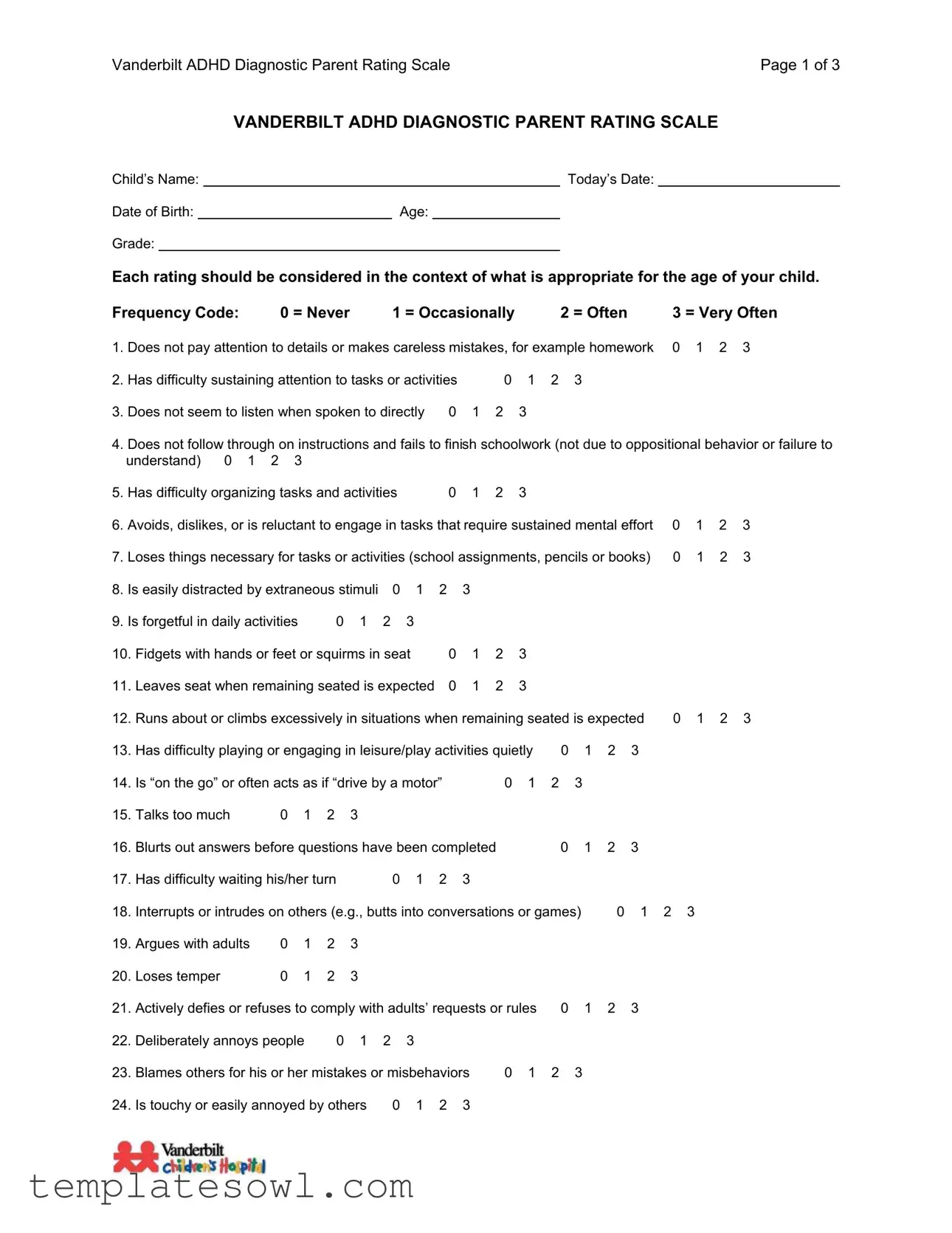What is the Vanderbilt Assessment Scale?
The Vanderbilt Assessment Scale is a tool designed to help identify Attention Deficit Hyperactivity Disorder (ADHD) in children and to evaluate related behavioral issues. It includes a series of questions that parents or guardians answer about their child's behavior, focusing on both inattention and hyperactivity-impulsivity symptoms. This comprehensive assessment helps clinicians arrive at an accurate diagnosis by collecting vital information directly from those who know the child best.
How does one fill out the form?
Filling out the Vanderbilt Assessment Scale is straightforward. Parents or guardians should read each statement carefully and select a frequency code to indicate how often the observed behavior occurs. The codes range from 0 (never) to 3 (very often). Additionally, a performance section evaluates the child's academic performance and classroom behavior, allowing for a fuller understanding of their struggles and strengths.
Why is age considered when completing the scale?
Age plays a crucial role in assessing a child's behavior. Expectations for behavior change as children develop. Therefore, understanding what is age-appropriate helps ensure that respondents evaluate behaviors in the right context. The rating scale accounts for these developmental milestones, enabling a more accurate diagnosis and intervention plan.
What if my child exhibits some concerning behaviors but does not meet the criteria for ADHD?
It’s normal for children to display certain behaviors that may mirror ADHD symptoms without actually having the disorder. The Vanderbilt Assessment Scale is not only a diagnostic tool for ADHD but also screens for other conditions, including oppositional-defiant disorder, conduct disorder, and anxiety or depression. Therefore, if concerns remain after filling out the form, it is essential to discuss them with a healthcare professional who can provide guidance on the next steps.
Who can use the Vanderbilt Assessment Scale?
This tool is primarily intended for parents or guardians of children between the ages of 6 and 12. However, educators and mental health professionals may also use the results to gain insights into the child's behavior in different settings. A well-rounded perspective can always be beneficial when seeking assistance for the child's challenges.
How do I score the Vanderbilt Assessment Scale?
The scoring process involves tallying the ratings provided for each behavior. Specific numerical thresholds determine the likelihood of ADHD and related disorders. For instance, items on inattention require certain scores, as do those on hyperactivity-impulsivity. These thresholds help clinicians identify whether a child meets the diagnostic criteria for the various types of ADHD or other behavioral issues.
What should I do with the completed form?
Once the Vanderbilt Assessment Scale is completed, it should be submitted to a healthcare provider, such as a pediatrician or child psychologist. They will review the results, discuss any concerns, and determine whether further evaluation or intervention is necessary. Having the assessment on hand can facilitate a more productive conversation about the child's needs.
Can the Vanderbilt Assessment Scale help with treatment options?
Yes, the Vanderbilt Assessment Scale serves as a foundational tool in understanding a child's challenges. Its results can guide treatment options, ranging from behavioral interventions to educational support and possibly medication. A thorough assessment provides the basis for tailored strategies that align with the child’s unique situation and needs.
Is the Vanderbilt Assessment Scale available in languages other than English?
The Vanderbilt Assessment Scale is widely used across different settings, and translations are available in several languages. To ensure accuracy and clarity, parents or guardians should actively seek out translated versions if needed. This helps maintain the integrity of the responses and supports effective communication in the assessment process.
Where can I obtain a copy of the Vanderbilt Assessment Scale?
The Vanderbilt Assessment Scale is often available through healthcare providers, schools, or mental health professionals. Additionally, many reliable online resources provide downloadable copies of the scale. Ensuring that you have the correct and most recent version is essential for accurate assessment.



